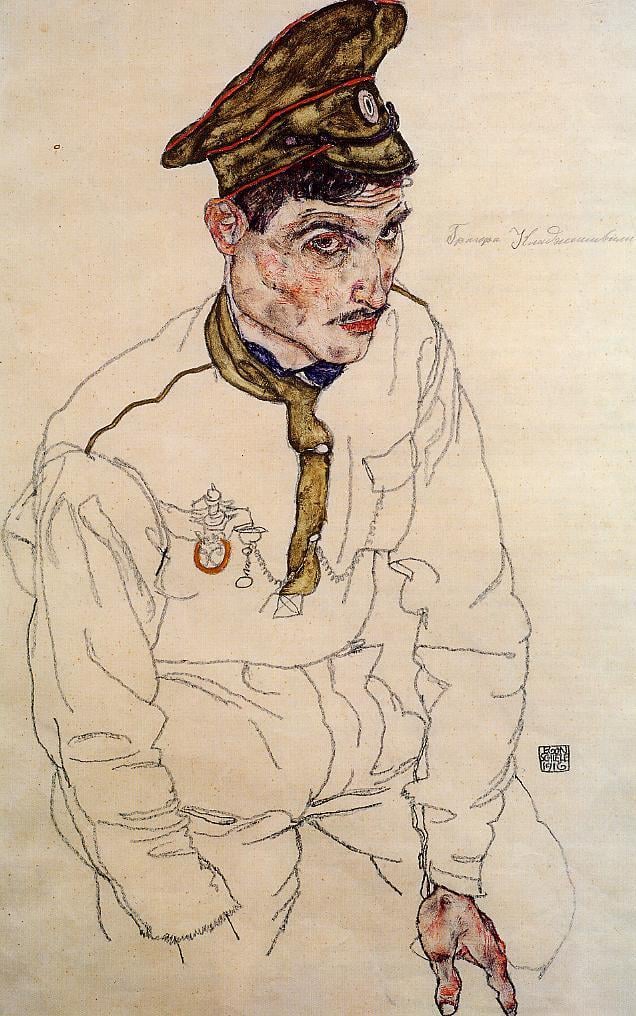
The Art Institute of Chicago has refused to turn over a drawing by Egon Schiele to New York investigators, according to a document filed in a New York Supreme Court this week. In the robust 132-page court filing, the museum soundly rejected claims that the work was looted by the Nazis.
Titled Russian War Prisoner (1917), the drawing is one of around 80 works by Schiele that have been traced back to the Austrian Jewish collector Fritz Grünbaum, who was murdered by Nazis at the Dachau concentration camp in 1941. Many of these works then entered the art market and have since ended up in international museums, according to Grünbaum’s heirs.
In February, Manhattan District Attorney Alvin Bragg’s office filed a 160-page application for a turnover order with the New York Supreme Court, laying out its case for why the work was stolen and should be returned to Grünbaum’s heirs: Timothy Reif, David Fraenkel, and Milos Vavra. The order is part of a larger criminal investigation into a historical smuggling operation allegedly run by the late Swiss dealer Eberhard Kornfeld and Austrian gallerist Otto Kallir, which brought Nazi-looted art from Europe into the U.S. via New York.
The Art Institute of Chicago, which acquired its drawing in 1966, is the only institution of eight U.S. museums that has not complied with similar turnover warrants from the Manhattan D.A. requesting Schiele works to be returned to the heirs.
“Our response provides specific details of the extensive evidence, documentation, and research that specifically refutes the allegations made by the Manhattan District Attorney,” said Megan Michienzi, a spokesperson for the Art Institute. “We cannot agree to set the precedent of returning this piece when the evidence clearly demonstrates the work was never stolen. ”
In this latest filing, dated April 23, the Art Institute has provided a counter-narrative for how the drawing left Grünbaum’s possession. Rather than being stolen by the Nazis in 1938, as alleged by investigators, it was apparently given by the collector to his sister-in-law who sold it to Kornfeld in 1956.
According to the document, which draws on records from the time, Grünbaum’s assets were registered by the Nazi authorities and his bank accounts and stocks were restricted. However, the filing says it cannot be proven that any equivalent actions were taken on his tangible assets, including his art collection and all of his works by Schiele.
“If physical seizure or confiscation of the Grünbaums’ property had taken place, this would have been an official act of dispossession for which there would exist documentation,” the document states. Instead, “never once, in decades of litigation and investigation squarely focused on the Grünbaums’ art collection, has a single shred of documentary evidence emerged to support the theory that the Nazi regime physically seized and then sold or otherwise disposed of the Grünbaums’ art collection, including Russian War Prisoner.”
In 1938, the collection was handed over to the moving company Schenker & Co, which investigators claimed was akin to surrendering it to the Nazis. The museum claims that the company applied for an export license to move the Grünbaum’s tangible assets to Belgium on behalf of Grünbaum’s wife Lilly. Further, according to the court filing, the evidence shows that Grünbaum’s sister-in-law Mathilde Lukacs, who survived the war, sold the work to Kornfeld who later sold it to Kallir.
Kornfeld testified to their professional relationship during the lengthy Bakalar vs. Vavra litigation between 2005 and 2012. He described selling over 100 works from Mathilde’s extensive collection, which is evidenced by their frequent correspondence during the 1950s. Quoted extensively in the Art Institute’s court filing, these letters refer to groups of unnamed works by Schiele.
Sales were also recorded in a handwritten ledgers, but the Manhattan investigators believe that these documents were falsified. They have also argued that even if the works were transferred to Lukacs, this cannot have been done voluntarily given the wider political context.
In an email, Matthew Bodganos, who heads the Antiquities Trafficking Unit at the district attorney’s office and authored the February turnover warrant, said “we will respond in court.”
The arguments set out by both sides have been debated in court before, resulting in contradictory court rulings. In 2018, a New York Supreme Court ruled in favor of the Grünbaum heirs but another federal court case sided with Kornfeld’s version of events.
The Grünbaum heirs also took matters into their own hands earlier this year, appealing a prior decision made by New York Federal Judge John Koeltl in a civil lawsuit filed against the museum. He upheld his decision to dismiss the heirs case, which he said has passed the statue of limitations, and barred the heirs from amending the case for reconsideration.
Seven other U.S. museums have complied with the Manhattan D.A’s turnover warrants, returning works by Schiele to the Grünbaum heirs. These include the Museum of Modern Art and the Morgan Library and Museum in New York, the Carnegie Museums of Pittsburgh, the Allen Memorial Art Museum at Oberlin College in Ohio, and the Santa Barbara Museum of Art in California. Works from several high-profile private collections have also been returned.